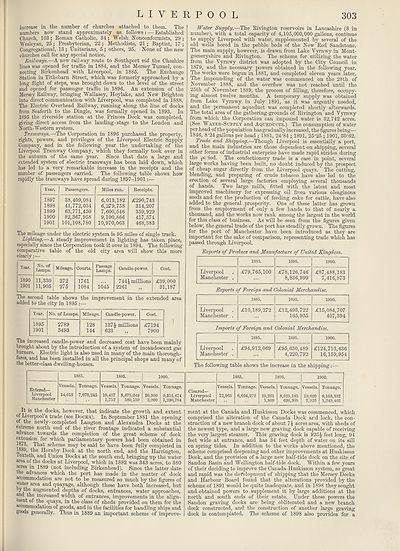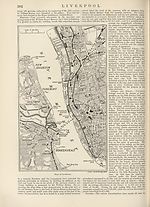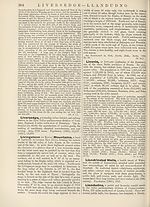New volumes of the Encyclopædia Britannica > Volume 30, K-MOR
(333) Page 303
Download files
Complete book:
Individual page:
Thumbnail gallery: Grid view | List view

LIVERPOOL
303
increase in the number of churches attached to them. The
numbers now stand approximately as follows: — Established
Church, 103; Roman Catholic, 34 ; Welsh Nonconformists, 29 ;
Wesleyan, 25 ; Presbyterian, 22; Methodists, 21 ; Baptist, 17 ;
Congregational, 13 ; Unitarians, 5 ; others, 25. None of the new
churches call for any special notice.
Railways.—A. new railway route to Southport vid the Cheshire
lines was opened for traffic in 1884, and the Mersey Tunnel, con¬
necting Birkenhead with Liverpool, in 1885. The Exchange
Station in Tithebarn Street, which was formerly approached by a
long flight of steps, was brought down to the level of the street
and opened for passenger traffic in 1896. An extension of the
Mersey Railway, bringing Wallasey, Hoylake, and New Brighton
into direct communication with Liverpool, was completed in 1888.
The Electric Overhead Railway, running along the line of docks
from Seaforth to the Dingle, was formally opened in 1893. In
1895 the riverside station at the Princes Dock was completed,
giving direct access from the landing-stage to the London and
North-Western system.
Tramways.—The Corporation in 1896 purchased the property,
rights, powers, and privileges of the Liverpool Electric Supply
Company, and in the following year the undertaking of the
Liverpool Tramway Company, which they formally took over in
the autumn of the same year. Since that date a large and
extended system of electric tramways has been laid down, which
has led to a very remarkable increase in the receipts and the
number of passengers carried. The following table shows how
rapidly the tramways have spread during 1897-1901:—
The mileage under the electric system is 95 miles of single track.
Lighting.—A steady improvement in lighting has taken place,
especially since the Corporation took it over in 1894. The following
comparative table of the old city area will show this more
clearly:—
Year.
1890
1901
No. of
Lamps.
11,330
11,905
Mileage.
272
275
Courts.
1761
1084
Passage
Lamps.
1045
Candle-power.
744J millions
2261
Cost.
£39,000
31,187
The second table shows the improvement in the extended area
added to the city in 1895 :—
Year.
1895
1901
No. of Lamps.
2789
3493
Mileage.
128
144
Candle-power.
137J millions
623
Cost.
£7194
7900
The increased candle-power and decreased cost have been mainly
brought about by the introduction of a system of incandescent gas
burners. Electric light is also used in many of the main thorough¬
fares, and has been installed in all the principal shops and many of
the better-class dwelling-houses.
Water Supply.—The Rivington reservoirs in Lancashire (8 in
number), with a total capacity of 4,105,000,000 gallons, continue
to supply Liverpool with water, supplemented by several of the
old wells bored in the pebble beds of the New Red Sandstone.
The main supply, however, is drawn from Lake Yyrnwy in Mont¬
gomeryshire and Rivington. The scheme for utilizing the water
from the Yyrnwy district was adopted by the City Council in
1879, and the necessary powers obtained in the following year.
The works were begun in 1881, and completed eleven years later.
The impounding of the water was commenced on the 28th of
November 1888, and the overflow was not reached until the
25th of November 1889, the process of filling, therefore, occupy¬
ing almost twelve months. A temporary supply was obtained
from Lake Vyrnwy in July 1891, as it was urgently needed,
and the permanent aqueduct was completed shortly afterwards.
The total area of the gathering-grounds of Rivington and Vyrnwy
from which the Corporation can impound water is 32,742 acres.
(See Water-Supply and Aqueducts.) The consumption of water
per head of the population has gradually increased, the figures being—
1846, 8-24 gallons per head ; 1881, 24'84 ; 1891, 25'25 ; 1901, 30'62.
Trade and Shipping.—Though Liverpool is essentially a port,
and the main industries are those dependent on shipping, several
other forms of industrial enterprise have made rapid strides during
the pe flod. The confectionery trade is a case in point, several
large works having been built, no doubt induced by the prospect
of cheap sugar directly from the Liverpool quays. The cutting,
blending, and preparing of crude tobacco have also led to the
erection of several large factories employing several thousands
of hands. Two large mills, fitted with the latest and most
improved machinery for expressing oil from various oleaginous
seeds and for the production of feeding cake for cattle, have also
added to the general prosperity. One of these latter has grown
from the employment of only a few hands to that of nearly a
thousand, and the works now rank among the largest in the world
for this class of business. As will be seen from the figures given
below, the general trade of the port has steadily grown. The figures
for the port of Manchester have been introduced as they are
important for the sake of comparison, representing trade which has
passed through Liverpool.
Exports of Produce and Manufacture of United Kingdom.
Liverpool
Manchester
£79,765,100
1895.
£78,126,746
8,836,999
1900.
£87,488,183
7,416,873
Exports of Foreign and Colonial Merchandise.
Liverpool
Manchester
£10,189,272
1895.
£12,493,722
165,935
£15,084,707
407,394
Imports of Foreign and Colonial Merchandise.
Liverpool
Manchester
£94,912,069
1895.
£95,630,489
4,220,792
£124,713,436
16,159,954
The following table shows the increase in the shipping:—
Entered—
Liverpool
Manchester
1885.
Vessels.
14,018
Tonnage.
7,070,245
1895.
Vessels. Tonnage.
19,457
1,752
8,675,049
589,159
Vessels. Tonnage.
20,300
2,900
9,315,674
1,230,784
Cleared—
Liverpool
Manchester
Vessels.
12,965
Tonnage.
6,624,272
Vessels. Tonnage.
19,261
1,809
8,525,185
636,305
1900.
Vessels. Tonnage.
19,620
2,926
9,158,332
1,249,463
It is the docks, however, that indicate the growth and extent
of Liverpool’s trade (see Docks). In September 1881 the opening
of the newly - completed Langton and Alexandra Docks at the
extreme north end of the river frontage indicated a substantial
advance towards the completion of the great scheme of dock
extension for which parliamentary powers had been obtained in
1873. That scheme may be said to have been fully completed in
1889, the Hornby Dock at the north end, and the Harrington,
loxteth, and Union Docks at the south end, bringing up the water
area of the docks at Liverpool, which in 1882 was 343 acres, to 380
fv?68 in (nc!t including Birkenhead). Since the latter date
the advances which the port has made in the matter of dock
accommodation are not to be measured so much by the figures of
water area and quayage, although these have both increased, but
Y.the augmented depths of docks, entrances, water approaches,
and the increased width of entrances, improvements in the align-
nient of the. quays, in the class of sheds provided on them for the
accommodation of goods, and in the facilities for handling ships and
goods generally. Thus in 1889 an important scheme of improve¬
ment at the Canada and Huskisson Docks was commenced, which
comprised the alteration of the Canada Dock and lock, the con¬
struction of a new branch dock of about 7J acres area, with sheds of
the newest type, and a large new graving dock capable of receiving
the very largest steamer. This graving dock is 925J feet long, 94
feet wide at entrance, and has 34 feet depth of water on its sill
on spring tides. In addition to the works above mentioned, the
scheme comprised deepening and other improvements at Huskisson
Dock, and the provision of a large new half-tide dock on the site of
Sandon Basin and Wellington half-tide dock. Within a few years
of their deciding to improve the Canada-Huskisson system, so great
and rapid was the development of shipping that the Mersey Docks
and Harbour Board found that the alterations provided by the
scheme of 1891 would be quite inadequate, and in 1898 they sought
and obtained powers to supplement it by large additions at the
north and south ends of their estate. Under these powers the
Sandon graving docks are being obliterated and a new branch
dock constructed, and the construction of another large graving
dock is contemplated. The scheme of 1898 also provides for a
303
increase in the number of churches attached to them. The
numbers now stand approximately as follows: — Established
Church, 103; Roman Catholic, 34 ; Welsh Nonconformists, 29 ;
Wesleyan, 25 ; Presbyterian, 22; Methodists, 21 ; Baptist, 17 ;
Congregational, 13 ; Unitarians, 5 ; others, 25. None of the new
churches call for any special notice.
Railways.—A. new railway route to Southport vid the Cheshire
lines was opened for traffic in 1884, and the Mersey Tunnel, con¬
necting Birkenhead with Liverpool, in 1885. The Exchange
Station in Tithebarn Street, which was formerly approached by a
long flight of steps, was brought down to the level of the street
and opened for passenger traffic in 1896. An extension of the
Mersey Railway, bringing Wallasey, Hoylake, and New Brighton
into direct communication with Liverpool, was completed in 1888.
The Electric Overhead Railway, running along the line of docks
from Seaforth to the Dingle, was formally opened in 1893. In
1895 the riverside station at the Princes Dock was completed,
giving direct access from the landing-stage to the London and
North-Western system.
Tramways.—The Corporation in 1896 purchased the property,
rights, powers, and privileges of the Liverpool Electric Supply
Company, and in the following year the undertaking of the
Liverpool Tramway Company, which they formally took over in
the autumn of the same year. Since that date a large and
extended system of electric tramways has been laid down, which
has led to a very remarkable increase in the receipts and the
number of passengers carried. The following table shows how
rapidly the tramways have spread during 1897-1901:—
The mileage under the electric system is 95 miles of single track.
Lighting.—A steady improvement in lighting has taken place,
especially since the Corporation took it over in 1894. The following
comparative table of the old city area will show this more
clearly:—
Year.
1890
1901
No. of
Lamps.
11,330
11,905
Mileage.
272
275
Courts.
1761
1084
Passage
Lamps.
1045
Candle-power.
744J millions
2261
Cost.
£39,000
31,187
The second table shows the improvement in the extended area
added to the city in 1895 :—
Year.
1895
1901
No. of Lamps.
2789
3493
Mileage.
128
144
Candle-power.
137J millions
623
Cost.
£7194
7900
The increased candle-power and decreased cost have been mainly
brought about by the introduction of a system of incandescent gas
burners. Electric light is also used in many of the main thorough¬
fares, and has been installed in all the principal shops and many of
the better-class dwelling-houses.
Water Supply.—The Rivington reservoirs in Lancashire (8 in
number), with a total capacity of 4,105,000,000 gallons, continue
to supply Liverpool with water, supplemented by several of the
old wells bored in the pebble beds of the New Red Sandstone.
The main supply, however, is drawn from Lake Yyrnwy in Mont¬
gomeryshire and Rivington. The scheme for utilizing the water
from the Yyrnwy district was adopted by the City Council in
1879, and the necessary powers obtained in the following year.
The works were begun in 1881, and completed eleven years later.
The impounding of the water was commenced on the 28th of
November 1888, and the overflow was not reached until the
25th of November 1889, the process of filling, therefore, occupy¬
ing almost twelve months. A temporary supply was obtained
from Lake Vyrnwy in July 1891, as it was urgently needed,
and the permanent aqueduct was completed shortly afterwards.
The total area of the gathering-grounds of Rivington and Vyrnwy
from which the Corporation can impound water is 32,742 acres.
(See Water-Supply and Aqueducts.) The consumption of water
per head of the population has gradually increased, the figures being—
1846, 8-24 gallons per head ; 1881, 24'84 ; 1891, 25'25 ; 1901, 30'62.
Trade and Shipping.—Though Liverpool is essentially a port,
and the main industries are those dependent on shipping, several
other forms of industrial enterprise have made rapid strides during
the pe flod. The confectionery trade is a case in point, several
large works having been built, no doubt induced by the prospect
of cheap sugar directly from the Liverpool quays. The cutting,
blending, and preparing of crude tobacco have also led to the
erection of several large factories employing several thousands
of hands. Two large mills, fitted with the latest and most
improved machinery for expressing oil from various oleaginous
seeds and for the production of feeding cake for cattle, have also
added to the general prosperity. One of these latter has grown
from the employment of only a few hands to that of nearly a
thousand, and the works now rank among the largest in the world
for this class of business. As will be seen from the figures given
below, the general trade of the port has steadily grown. The figures
for the port of Manchester have been introduced as they are
important for the sake of comparison, representing trade which has
passed through Liverpool.
Exports of Produce and Manufacture of United Kingdom.
Liverpool
Manchester
£79,765,100
1895.
£78,126,746
8,836,999
1900.
£87,488,183
7,416,873
Exports of Foreign and Colonial Merchandise.
Liverpool
Manchester
£10,189,272
1895.
£12,493,722
165,935
£15,084,707
407,394
Imports of Foreign and Colonial Merchandise.
Liverpool
Manchester
£94,912,069
1895.
£95,630,489
4,220,792
£124,713,436
16,159,954
The following table shows the increase in the shipping:—
Entered—
Liverpool
Manchester
1885.
Vessels.
14,018
Tonnage.
7,070,245
1895.
Vessels. Tonnage.
19,457
1,752
8,675,049
589,159
Vessels. Tonnage.
20,300
2,900
9,315,674
1,230,784
Cleared—
Liverpool
Manchester
Vessels.
12,965
Tonnage.
6,624,272
Vessels. Tonnage.
19,261
1,809
8,525,185
636,305
1900.
Vessels. Tonnage.
19,620
2,926
9,158,332
1,249,463
It is the docks, however, that indicate the growth and extent
of Liverpool’s trade (see Docks). In September 1881 the opening
of the newly - completed Langton and Alexandra Docks at the
extreme north end of the river frontage indicated a substantial
advance towards the completion of the great scheme of dock
extension for which parliamentary powers had been obtained in
1873. That scheme may be said to have been fully completed in
1889, the Hornby Dock at the north end, and the Harrington,
loxteth, and Union Docks at the south end, bringing up the water
area of the docks at Liverpool, which in 1882 was 343 acres, to 380
fv?68 in (nc!t including Birkenhead). Since the latter date
the advances which the port has made in the matter of dock
accommodation are not to be measured so much by the figures of
water area and quayage, although these have both increased, but
Y.the augmented depths of docks, entrances, water approaches,
and the increased width of entrances, improvements in the align-
nient of the. quays, in the class of sheds provided on them for the
accommodation of goods, and in the facilities for handling ships and
goods generally. Thus in 1889 an important scheme of improve¬
ment at the Canada and Huskisson Docks was commenced, which
comprised the alteration of the Canada Dock and lock, the con¬
struction of a new branch dock of about 7J acres area, with sheds of
the newest type, and a large new graving dock capable of receiving
the very largest steamer. This graving dock is 925J feet long, 94
feet wide at entrance, and has 34 feet depth of water on its sill
on spring tides. In addition to the works above mentioned, the
scheme comprised deepening and other improvements at Huskisson
Dock, and the provision of a large new half-tide dock on the site of
Sandon Basin and Wellington half-tide dock. Within a few years
of their deciding to improve the Canada-Huskisson system, so great
and rapid was the development of shipping that the Mersey Docks
and Harbour Board found that the alterations provided by the
scheme of 1891 would be quite inadequate, and in 1898 they sought
and obtained powers to supplement it by large additions at the
north and south ends of their estate. Under these powers the
Sandon graving docks are being obliterated and a new branch
dock constructed, and the construction of another large graving
dock is contemplated. The scheme of 1898 also provides for a
Set display mode to:
![]() Universal Viewer |
Universal Viewer | ![]() Mirador |
Large image | Transcription
Mirador |
Large image | Transcription
Images and transcriptions on this page, including medium image downloads, may be used under the Creative Commons Attribution 4.0 International Licence unless otherwise stated. ![]()
| Encyclopaedia Britannica > New volumes of the Encyclopædia Britannica > Volume 30, K-MOR > (333) Page 303 |
|---|
| Permanent URL | https://digital.nls.uk/193571830 |
|---|
| Attribution and copyright: |
|
|---|---|
| Shelfmark | EB.18 |
|---|---|
| Description | Ten editions of 'Encyclopaedia Britannica', issued from 1768-1903, in 231 volumes. Originally issued in 100 weekly parts (3 volumes) between 1768 and 1771 by publishers: Colin Macfarquhar and Andrew Bell (Edinburgh); editor: William Smellie: engraver: Andrew Bell. Expanded editions in the 19th century featured more volumes and contributions from leading experts in their fields. Managed and published in Edinburgh up to the 9th edition (25 volumes, from 1875-1889); the 10th edition (1902-1903) re-issued the 9th edition, with 11 supplementary volumes. |
|---|---|
| Additional NLS resources: |
|

